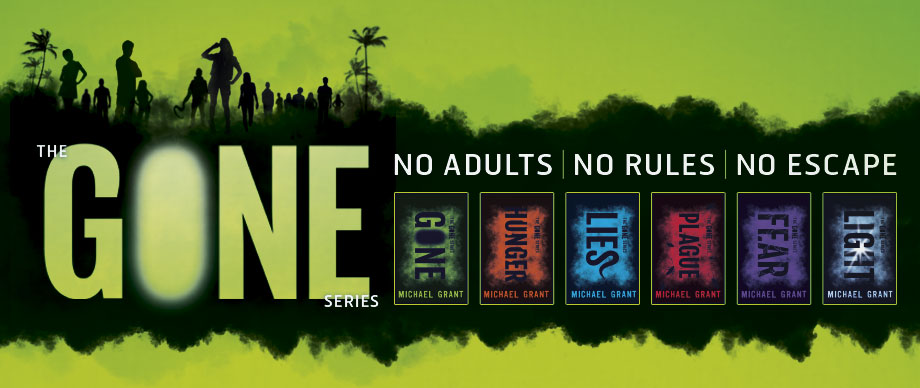
‘Gone’ series review
By Lauren Kelly, Editor-in-Chief
4.5/5
What would you do if one day everyone over the age of 15 disappeared? Just vanished into thin air? Gone?
Well, I guess we’d be gone too, actually. But for the 14 and younger characters in Michael Grant’s Gone series, this is the start of something incredibly sinister and traumatic—something that we would be incredibly lucky to be gone for.
The plot of the first book, Gone, revolves heavily around this. When all of the adults in Perdido Beach disappear, the town’s panicked children rally behind Sam Temple, the primary protagonist and reluctant chosen leader. He and his crush Astrid the Genius take it upon themselves to learn more about their predicament.
Through further investigation, they discover that they’ve been trapped under a 20-mile diameter opaque dome. One kid comes up with a nickname for their new home—the FAYZ, or Fallout Alley Youth Zone, so named for their town’s reputation after their nuclear power plant was hit with a meteor 15 years prior.
If all of this wasn’t enough for these kids, some of them begin mutating powers, including Sam’s ability to create balls and beams of light.
Up the hill from Perdido Beach is Coates Academy, a school for difficult children. Caine Soren, Coates’ self-appointed leader and another mutant, sees the FAYZ as an opportunity to stage a take-over of Perdido Beach. And behind the scenes of this all, there is a more sinister power at play—the Darkness.
Michael Grant’s Gone series was published between 2008–2013 and spans six books: Gone, Hunger, Lies, Plague, Fear, and Light. The books deal with the interpersonal struggles of the characters as they jockey for power, create their own places in the FAYZ, or just attempt to stay under the radar. However, none of this proves to be too easy, as without any authority figures around to keep order, the town falls apart. Each of the books’ plots follows the theme of the title—for example, a large portion of Hunger follows the children’s struggles with starvation and setting up a consistent food system.
The chapters of each book begin with a countdown that shows you how much time is left until the book’s climax. It’s an interesting strategy, and one that kept me anxious as I watched the action unfold, wondering just what was going to happen when the countdown reached zero. Each book contains major revelations, and very rarely seems predictable. The character development is superb, and even minor characters are very well fleshed out.
Another interesting tactic is that the books constantly change perspective, often in the same chapter, so you always have an idea of what’s going on inside the major and minor characters’ heads. Many of the characters are under immense amounts of pressure, such as Mary, who runs the daycare and takes care of the littles, and Dahra, the “nurse” who handles everyone’s injuries and illnesses with an old medical textbook. Others see the FAYZ as an opportunity, like Albert, a neglected youngest-sibling who begins running Perdido Beach’s abandoned McDonald’s, with aspirations to do more.
I guess I’ve been out of the YA lit sphere for awhile, but I was consistently surprised at how dark and brutal these books are, and they only became more so as the series went on. There is omnipresent and very detailed violence and death, but also kids struggling with alcoholism, depression, bulimia, self-loathing, and racism. I appreciated Grant’s boldness at killing or hurting his characters, many of whom were lovingly written and developed. Maybe I shouldn’t have been too shocked, though—Grant co-wrote the Animorphs series, which is known for its surprisingly dark themes and gruesome battles.
The series is incredibly diverse, which I was pleasantly surprised by. Not only that, but it depicted discrimination against these characters realistically. Many of the strongest mutants are women, including Brianna (“The Breeze”), who has super speed; Dekka, who can cancel gravity; Taylor, who can teleport; and Lana, who can heal. Racially, the series is diverse as well. Taylor is East Asian; Albert, Dahra, and Dekka are all black, with Dahra being from Ghana; and Edilio, one of Sam’s closest friends in the FAYZ, is Honduran. Also, Dekka is a lesbian, and a few other characters discover their sexuality throughout the series.
All in all, this series consistently impressed me. I wasn’t sure what to expect when I got into them, but I really fell for the books and cared about the characters. There were a few things that didn’t work as well for me—mostly involving The Darkness and Astrid’s brother, Little Petey—but Grant’s story overall was told superbly. I would easily recommend this series to any fan of YA Lit, the Animorphs, or Stephen King, whose influence is felt on the pages. Now is the perfect time to pick it up, as Grant recently announced book seven of the series, Monster, which will be released October 17.

